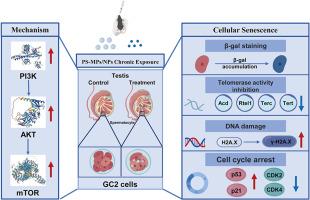长期暴露于聚苯乙烯微/纳米塑料会通过PI3K/AKT/mTOR信号介导的小鼠精细胞衰老引发睾丸功能障碍。
IF 3.5
3区 医学
Q2 FOOD SCIENCE & TECHNOLOGY
引用次数: 0
摘要
虽然潜在的微塑料毒性引起了相当大的研究关注,但其对雄性哺乳动物慢性生殖影响的研究仍然有限。本研究采用GC2细胞体外实验和C57雄性小鼠体内实验,研究了聚苯乙烯微塑料(PS-MPs, 5 μm)和聚苯乙烯纳米塑料(PS-NPs, 20 nm)的慢性生殖毒性。组织病理学分析显示,治疗组精管扩张,精母细胞紊乱,精母细胞计数减少。一致地,暴露于PS-MPs和PS-NPs后,精子数量和活力显著降低。这些作用与精母细胞衰老密切相关,如β-半乳糖苷酶活性和端粒酶抑制、DNA损伤和细胞周期阻滞的标记所示。在机制上,PS-MPs和PS-NPs通过激活PI3K/AKT/mTOR信号通路触发精母细胞衰老。我们的研究结果表明,PS-MPs和PS-NPs引起小鼠睾丸结构损伤和生精功能障碍,可能通过PI3K/AKT/mTOR途径介导精母细胞衰老。本文章由计算机程序翻译,如有差异,请以英文原文为准。

Chronic exposure to polystyrene micro/nanoplastics triggers testicular dysfunction through PI3K/AKT/mTOR signaling-mediated spermatocyte senescence in mice
While the potential microplastic toxicity has attracted considerable research attention, studies on its chronic reproductive effects in male mammals remain limited. Here, we investigated the chronic reproductive toxicity of polystyrene microplastics (PS-MPs, 5 μm) and polystyrene nanoplastics (PS-NPs, 20 nm) both in vitro, using GC2 cells, and in vivo, employing male C57 mice. Histopathological analysis revealed dilated seminiferous tubules, disorganized spermatocytes, and reduced spermatocyte counts in treated groups. Consistently, sperm count and motility were significantly decreased following PS-MPs and PS-NPs exposure. These effects were closely associated with spermatocyte senescence, as indicated by β-galactosidase activity and the markers of telomerase inhibition, DNA damage, and cell cycle arrest. Mechanistically, PS-MPs and PS-NPs trigger spermatocyte senescence through activation of the PI3K/AKT/mTOR signaling pathway. Our findings demonstrate that PS-MPs and PS-NPs cause structural damage and spermatogenic dysfunction in mouse testes, potentially mediated by spermatocyte senescence through the PI3K/AKT/mTOR pathway.
求助全文
通过发布文献求助,成功后即可免费获取论文全文。
去求助
来源期刊

Food and Chemical Toxicology
工程技术-毒理学
CiteScore
10.90
自引率
4.70%
发文量
651
审稿时长
31 days
期刊介绍:
Food and Chemical Toxicology (FCT), an internationally renowned journal, that publishes original research articles and reviews on toxic effects, in animals and humans, of natural or synthetic chemicals occurring in the human environment with particular emphasis on food, drugs, and chemicals, including agricultural and industrial safety, and consumer product safety. Areas such as safety evaluation of novel foods and ingredients, biotechnologically-derived products, and nanomaterials are included in the scope of the journal. FCT also encourages submission of papers on inter-relationships between nutrition and toxicology and on in vitro techniques, particularly those fostering the 3 Rs.
The principal aim of the journal is to publish high impact, scholarly work and to serve as a multidisciplinary forum for research in toxicology. Papers submitted will be judged on the basis of scientific originality and contribution to the field, quality and subject matter. Studies should address at least one of the following:
-Adverse physiological/biochemical, or pathological changes induced by specific defined substances
-New techniques for assessing potential toxicity, including molecular biology
-Mechanisms underlying toxic phenomena
-Toxicological examinations of specific chemicals or consumer products, both those showing adverse effects and those demonstrating safety, that meet current standards of scientific acceptability.
Authors must clearly and briefly identify what novel toxic effect (s) or toxic mechanism (s) of the chemical are being reported and what their significance is in the abstract. Furthermore, sufficient doses should be included in order to provide information on NOAEL/LOAEL values.
 求助内容:
求助内容: 应助结果提醒方式:
应助结果提醒方式:


